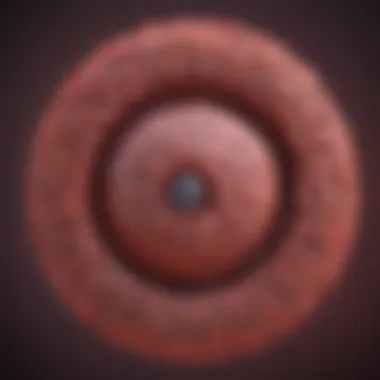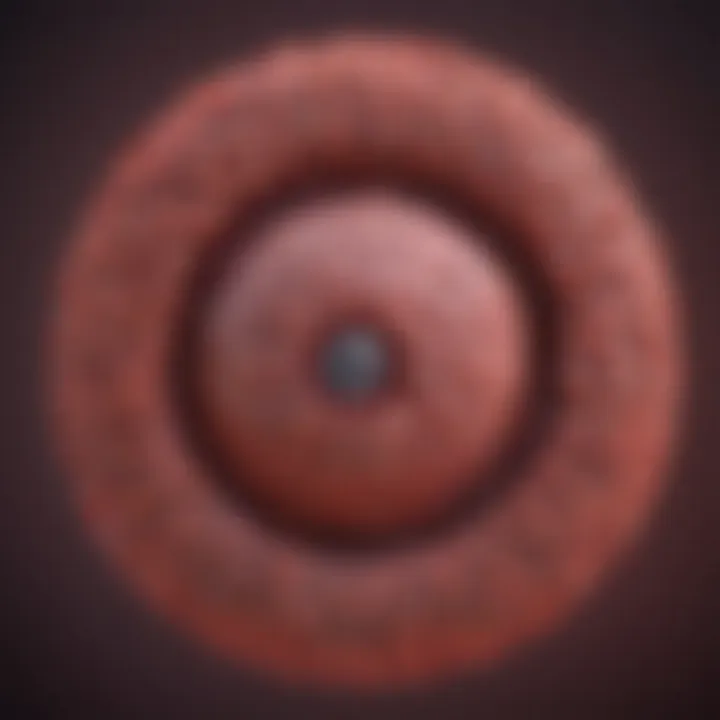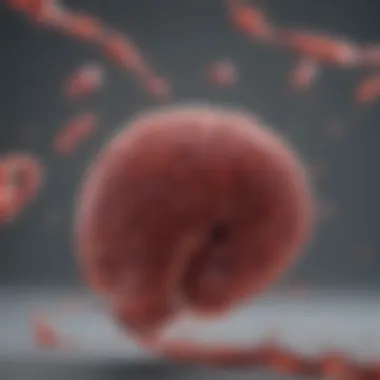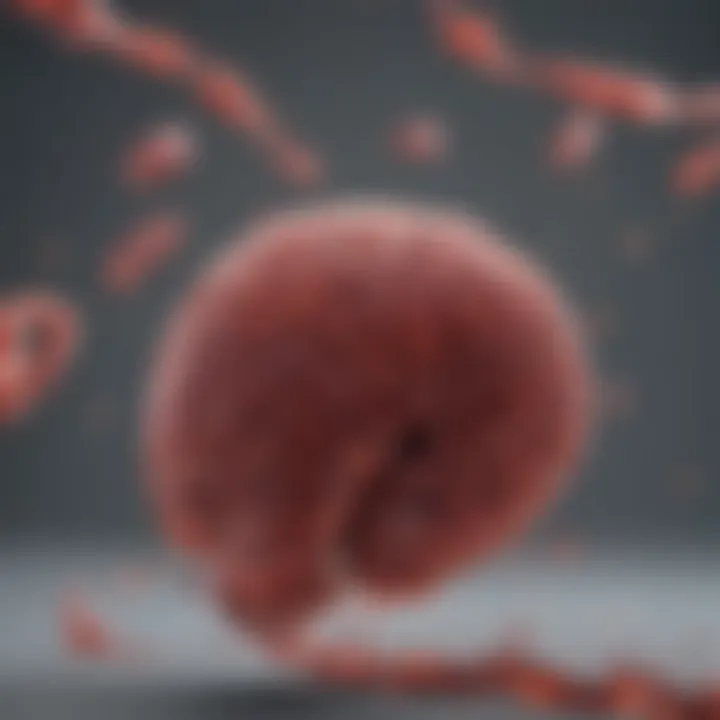Understanding Non-Infectious Hepatitis: Causes and Treatment


Intro
Non-infectious hepatitis represents a complex and multifaceted field of study, distinct from its more commonly known infectious counterparts. While viral hepatitis tends to steal the spotlight, shedding light on factors beyond those caused by pathogens is equally significant. Understanding this condition requires a deep dive into various elements—including causes, therapy options, and preventive strategies—that play a pivotal role in liver health. If you thought liver diseases only fell into the infectious category, think again. The insights explored in this article aim to broaden the perspectives of students, researchers, and healthcare professionals alike, uncovering the various aspects of non-infectious hepatitis.
Key Concepts and Terminology
Definition of Key Terms
To navigate the complexities of non-infectious hepatitis effectively, it's crucial to clarify several key terms:
- Hepatitis: Generally refers to inflammation of the liver, which can stem from various sources.
- Non-infectious hepatitis: Specifically indicates hepatitis caused by factors other than viral infections, such as medication, toxins, or autoimmune issues.
- Toxic hepatitis: A form of liver inflammation resulting from exposure to harmful substances, including medications or environmental toxins.
- Autoimmune hepatitis: A condition where the body's immune system mistakenly attacks liver cells, causing inflammation.
Concepts Explored in the Article
As we delve into this exploration, we will discuss the following concepts—each critical for understanding the underlying mechanisms of non-infectious hepatitis:
- Causes ranging from medications to dietary habits that can lead to liver damage.
- The intricate workings of the liver and how lifestyle choices can affect its function.
- Diagnostic methodologies and how they differ from infectious hepatitis diagnosis.
- Available treatment options tailored for non-infectious forms.
- Preventive measures that can help protect against liver damage.
Findings and Discussion
Main Findings
Through comprehensive exploration, several key findings emerge:
- Diverse Etiology: Non-infectious hepatitis can arise from a myriad of causes. For instance, overuse of common medications like acetaminophen may result in significant liver injury.
- Diagnosis Complexity: Identifying non-infectious hepatitis often requires a nuanced approach, including a detailed patient history and specific laboratory tests, as typical viral markers may not be present.
- Impact of Lifestyle: Emerging evidence highlights the influence dietary habits and alcohol consumption have on liver health, indicating that choices made daily carry weight.
"Recognizing the diverse array of factors contributing to liver inflammation is vital for finding effective treatments and preventing further harm."
Potential Areas for Future Research
The relentless rise in liver disease calls for further investigation, particularly in non-infectious hepatitis. Some potential area for future research includes:
- Expanding Knowledge on Autoimmunity: Understanding how autoimmune responses trigger non-infectious hepatitis could open avenues for new therapies.
- Public Awareness Campaigns: Designing initiatives to educate the public on the risks of over-the-counter drugs can mitigate occurrences of toxic hepatitis.
- Nutritional Studies: Investigating the role of specific diets and supplements in liver health may provide insights into preventive strategies.
In sum, this exploration serves to highlight the relevance of non-infectious hepatitis as a critical area of research and healthcare discussion, revealing its complexities and the need for continued investigation into its various facets.
Prolusion to Non-Infectious Hepatitis
Understanding non-infectious hepatitis is crucial in today’s world, especially as liver diseases gain prominence across the globe. These conditions don’t stem from viral infections, but from various factors that can influence liver health. In this article, we peel back the layers of complexity surrounding non-infectious hepatitis, aiming to provide a thorough insight into its causes, symptoms, and possible management strategies.
In discussing this topic, we find ourselves at a critical intersection. Recognizing non-infectious hepatitis could help health professionals better diagnose and treat patients. With increased awareness, individuals might take proactive steps to protect their liver, ultimately leading to better health outcomes. Understanding the distinction between infectious and non-infectious types is not just academic; it’s a matter of life and death for some.
The moment we delve into this area, we discover a tapestry of different categories under non-infectious hepatitis that requires our attention. This exploration is designed to equip you with knowledge that extends beyond the basics, highlighting how lifestyle choices, genetic predispositions, and environmental factors interweave to affect liver function.
"An ounce of prevention is worth a pound of cure" — and this rings especially true for liver health. By comprehending what non-infectious hepatitis entails, you can better identify risk factors and approach treatment in a more informed manner.
As we proceed, you’ll gain a clearer understanding of how non-infectious hepatitis differs and what that means for treatment and management. Knowing these distinctions will empower both patients and healthcare providers alike, driving home the point that knowledge is indeed power.
Definition and Overview
Non-infectious hepatitis describes a spectrum of liver inflammation that arises not from viral infections, but due to various non-viral factors. This condition can be seen in several forms, each with its own set of triggers and implications.
At its core, hepatitis involves the liver becoming inflamed, leading to a variety of health issues. This inflammation can be due to autoimmune reactions, the accumulation of fat in liver cells (often seen in conditions like fatty liver disease), exposure to certain toxins, or reactions to medications.
Each of these forms varies significantly in terms of etiology and management. For instance, autoimmune hepatitis involves the immune system attacking the liver cells as if they were foreign invaders, while fatty liver disease is frequently tied to obesity and metabolic syndrome. Understanding these differences is paramount to crafting effective treatment plans.
Importance of Distinguishing Between Types
It's not always a straightforward path when looking at non-infectious hepatitis. Distinguishing between the various types is essential, as it allows for tailored treatment options.
- Autoimmune hepatitis requires immunosuppressive therapy, while
- Fatty liver disease often targets lifestyle changes such as diet and exercise.
- Toxic hepatitis, on the other hand, might necessitate immediate removal of the offending substance.
Recognizing the differences can steer medical professionals towards the right interventions. For example, a patient presenting with jaundice and fatigue won’t benefit from the same treatment if the underlying cause is autoimmune compared to if it’s toxicity-related. Without this nuance, treatments may not only fail but could potentially exacerbate the patient’s condition.
In summary, understanding non-infectious hepatitis isn't just an academic exercise. It's a vital part of effective healthcare, underscoring the importance of individual patient history and the specificity of various liver conditions.
Types of Non-Infectious Hepatitis
The word 'hepatitis' often conjures thoughts of viral infections, yet there's a whole other facet to consider—non-infectious forms of liver inflammation. Understanding the types of non-infectious hepatitis is crucial for identifying risks and treatment paths. Each type can stem from different origins, and unraveling these distinctions lays the groundwork for effective management and prevention strategies.
With various lifestyle choices, environmental interactions, and even genetic factors coming into play, recognizing the specific nature of non-infectious hepatitis could be the key to better health outcomes.
Autoimmune Hepatitis
In autoimmune hepatitis, the body's own immune system turns on the liver, mistakenly identifying it as a threat. The reasons this occurs aren’t fully clear, but genetics might play a part. People suffering from this condition may experience constant fatigue, abdominal discomfort, and jaundice as the liver becomes inflamed.


Some symptoms might be elusive, akin to trying to catch smoke with bare hands, making diagnosis challenging. Often, the case is that these patients show elevated liver enzymes along with particular autoantibodies in their blood, which are telltale signs of this condition. Treatment typically involves immunosuppressive medications to bring that rogue immune response back in line.
Fatty Liver Disease
Fatty liver disease, particularly the non-alcoholic variant, has gained a reputation as a silent epidemic. In this scenario, excess fat accumulates in liver cells, leading to inflammation and damage. Picture the liver overstuffed like a burrito bursting at the seams—eventually, it can’t handle more.
Risk factors include obesity, diabetes, and high cholesterol. Individuals may not notice symptoms at first, but prolonged exposure can lead to more serious liver complications, like cirrhosis. To manage fatty liver disease, dietary changes, weight management, and physical activity often become the cornerstone of treatment. Keeping close tabs on what goes in your mouth at meal times can make a tangible difference.
Toxic Hepatitis
Toxic hepatitis is another flavor of non-infectious hepatitis fueled by environmental toxins or chemical exposures. This form of liver inflammation can manifest following contact with harmful substances in the workplace, household, or certain herbal remedies. It stands out because of its direct link to exogenous agents, such as heavy metals or solvents.
Symptoms can pop up quickly, often manifesting as nausea, vomiting, and jaundice, resembling other types of liver diseases. The best approach here is to identify the toxin and eliminate exposure, alongside supportive treatment to help the liver recover.
Drug-Induced Hepatitis
Drug-induced hepatitis surfaces when certain medications lead to liver damage. Over-the-counter pain relievers like acetaminophen, when consumed in excess, can cause serious harm. Even some prescription medications intended to heal can backfire, leading to inflammation.
Patients may exhibit liver enzyme elevations or jaundice, which should serve as red flags. In these cases, a thorough review of medications helps identify culprits, providing an opportunity to switch or cease the offending drug and allow the liver to heal. Awareness and meticulous self-monitoring can go a long way to avoid potential pitfalls.
Pathophysiology of Non-Infectious Hepatitis
Understanding the pathophysiology of non-infectious hepatitis is crucial for grasping how this condition silently disrupts liver function. Delving into the mechanisms behind liver injury and the subsequent inflammatory responses not only sheds light on the intricate workings of the liver but also highlights the critical implications for individuals affected by this disease. The liver, being a resilient organ, can endure considerable damage, yet the processes leading to dysfunction can remain unnoticed until substantial harm has occurred. Thus, recognizing these elements can assist healthcare professionals in timely intervention and can inform preventive strategies among at-risk populations.
Mechanisms of Liver Injury
Liver injury in non-infectious hepatitis often arises from various biochemical mechanisms. Here are some key pathways that can lead to damage:
- Oxidative Stress: This is fundamentally the imbalance between free radicals and antioxidants in the body. Excessive oxidative stress can directly damage liver cells or hepatocytes, initiating a cascade of inflammation.
- Immune-mediated Damage: In autoimmune hepatitis, the body's immune system erroneously targets liver cells, mistaking them for foreign invaders. This can lead to significant cellular disruption.
- Exposure to Toxins: Various environmental toxins, such as heavy metals or industrial chemicals, can induce liver injury as they get metabolized by the liver, producing harmful metabolites that lead to cell death.
In short, these mechanisms showcase how insidious factors can culminate in liver injury, necessitating a comprehensive understanding to effectively address prevention and treatment options for those affected.
Inflammatory Response Within the Liver
Once liver injury occurs, the inflammatory response kicks in, making it a significant aspect of non-infectious hepatitis. Here’s an overview of how this process unfolds:
- Activation of Immune Cells: Liver macrophages, also called Kupffer cells, along with other immune cells are activated when injury is detected. This leads to a localized inflammatory reaction.
- Cytokine Release: Damaged cells release signaling molecules known as cytokines, which draw more immune cells to the site of injury. This process, while essential for healing, can amplify tissue damage if not regulated.
- Fibrosis Development: Prolonged inflammation can lead to fibrosis or scarring of the liver. When this occurs, the liver's architecture alters, ultimately risking liver function.
The persistence of inflammation and resultant fibrosis can be detrimental, emphasizing the need for early diagnosis and management.
Understanding the inflammatory response provides a more profound insight into the chronic nature of non-infectious hepatitis and underscores the importance of addressing both the injury and the body’s reaction to it.
Risk Factors for Non-Infectious Hepatitis
Understanding the risk factors for non-infectious hepatitis is crucial for grasping how this condition can develop and impact liver health. Non-infectious hepatitis does not come from a virus, yet it can be just as damaging to the liver and the overall well-being of individuals. By identifying the factors that contribute to its onset, healthcare professionals can work towards better prevention strategies, timely interventions, and tailored treatments. This section delves into key aspects including genetic predispositions, environmental factors, and lifestyle choices that directly influence the likelihood of non-infectious hepatitis.
Genetic Predisposition
Genetic predisposition plays a pivotal role in the development of non-infectious hepatitis. Some individuals may inherit specific traits or mutations that can affect the liver's ability to function. For instance, mutations in genes related to connective tissue disorders can lead to conditions like autoimmune hepatitis where the body's immune system mistakenly attacks liver cells. This aspect emphasizes the importance of family medical history in assessing the risk of liver-related issues.
Moreover, certain genetic syndromes, like hemochromatosis, cause iron overload in the liver, ultimately leading to its damage. Therefore, screenings for family history and genetic testing may prove beneficial in recognizing those at risk before symptoms manifest. Understanding these genetic markers encourages a proactive approach to monitor and potentially mitigate any liver damage that may arise.
Environmental Exposures
Environmental factors also serve as significant contributors to non-infectious hepatitis. Individuals may encounter various hazards in their surroundings that directly impact liver health. For example, prolonged exposure to hazardous chemicals such as solvents, heavy metals, and pesticides can lead to toxic hepatitis, where harmful substances cause inflammation and damage.
Additionally, occupational hazards may increase risk. Workers in industries like manufacturing or agriculture might be at greater risk due to their exposure to such toxins. Hence, understanding one's working environment and adopting safety measures can help limit exposure.
Another key element is the role of air and water quality. Pollutants and contaminants can accumulate and affect overall health, including liver function. Shifting towards cleaner environments, both at home and work, is essential in reducing the exposure to potentially harmful substances.
Lifestyle Choices and Dietary Factors
Lastly, lifestyle choices and dietary habits can significantly impact the incidence and severity of non-infectious hepatitis. High consumption of alcohol is often linked to alcoholic liver disease, but excessive use of alcohol can also exacerbate conditions like fatty liver disease. Choosing moderation is a key component of maintaining liver health.
Dietary habits, too, play an integral role. Diets high in saturated fats and sugar can lead to fatty liver disease, while lacking essential nutrients may leave the liver vulnerable to damage. Incorporating a variety of fruits, vegetables, whole grains, and lean proteins can support liver function and overall health.
In summary, the risk factors associated with non-infectious hepatitis highlight the complex interplay between genetics, environment, and lifestyle. Understanding these elements is vital for prevention, intervention, and enhancing liver health. Monitoring these factors closely can lead to better outcomes and a more profound understanding of managing and preventing liver diseases.
Signs and Symptoms
Recognizing the signs and symptoms of non-infectious hepatitis is crucial for timely diagnosis and effective management. Understanding these manifestations helps differentiate this condition from infectious liver diseases and guides healthcare professionals in choosing appropriate interventions. The liver, despite its resilience, can reveal much about a person's overall health through its reactions to various stressors. Therefore, being in tune with these indicators can lead to earlier detection and treatment, potentially improving outcomes significantly.
Common Early Symptoms
When non-infectious hepatitis begins, individuals may experience symptoms that can easily be mistaken for other ailments. Early identification of these signs is instrumental. Some common early symptoms include:


- Fatigue: People often report feeling unusually tired, which might be attributed to various factors.
- Loss of appetite: A sudden decrease in hunger could be a red flag that something is amiss.
- Nausea: Unexplained waves of nausea can disrupt daily activities, prompting a closer look at one’s health.
- Mild abdominal discomfort: Many patients notice a sense of fullness or minor discomfort in the upper right quadrant of the abdomen, where the liver resides.
These early signs can be subtle and often lead individuals to dismiss them. However, they are significant in raising suspicion for non-infectious hepatitis. Recognizing them early can encourage patients to seek medical advice, paving the way for further investigatory procedures.
"Recognizing early symptoms can make all the difference in outcomes, turning a blind eye can lead to real underlying problems."
Chronic Manifestations
As non-infectious hepatitis progresses, symptoms can evolve into more chronic manifestations. The implications of ignoring early signs become glaringly apparent when these more severe symptoms arise:
- Jaundice: A yellowing of the skin and eyes may develop, indicating a buildup of bilirubin due to liver dysfunction.
- Ascites: This condition involves the accumulation of fluid in the abdomen, which can lead to discomfort and pressure.
- Itching: Patients often describe intense itching, which can be both frustrating and debilitating.
- Weight loss: Unintentional weight loss may occur as the body struggles to process nutrients properly, a sign that warrants immediate medical attention.
- Confusion or cognitive issues: Some may experience difficulties with memory or concentration, potentially indicating a more advanced condition affecting brain function.
The progression from early symptoms to chronic conditions underscores the importance of understanding and monitoring one's liver health. Addressing these issues sooner rather than later can significantly improve one’s quality of life. Thus, education around these symptoms becomes essential not only for patients but for practitioners who aim to provide the best care possible.
Diagnosis of Non-Infectious Hepatitis
Diagnosing non-infectious hepatitis is a multifaceted process that requires a keen eye and a systematic approach. It's vital to discern this condition from its infectious counterparts, especially since its underlying causes can range from autoimmune responses to harmful substances in our environment. For health professionals, having a solid grasp on the diagnostic framework is not just about identifying the ailment; it also significantly impacts treatment decisions and patient outcomes.
Clinical Evaluation
The first step in diagnosing non-infectious hepatitis often involves a thorough clinical evaluation. Healthcare providers typically begin by gathering a detailed medical history. This includes inquiries about current symptoms, past illnesses, medications, and lifestyle factors such as alcohol consumption and dietary habits.
The clinician may ask questions like:
- Have you experienced any unexplained fatigue or jaundice?
- Are there specific dietary habits that could have contributed to your condition?
- Have you been exposed to any toxins or certain medications?
Physical examination follows this history-taking. Signs such as hepatomegaly or jaundice can help guide the diagnosis. Here, the clinician's insight into correlating clinical signs with possible underlying causes is crucial.
Laboratory Testing
Laboratory testing forms the backbone of an effective diagnosis for non-infectious hepatitis. Blood tests, for example, can provide valuable insights into liver function and overall health.
- Liver Function Tests (LFTs): These tests evaluate the levels of liver enzymes like alanine aminotransferase (ALT) and aspartate aminotransferase (AST). Elevated levels can indicate liver damage but must be interpreted in context.
- Autoantibody Tests: In cases where autoimmune hepatitis is suspected, testing for specific autoantibodies can help confirm the diagnosis. The presence of these antibodies suggests the body is mistakenly targeting its own liver tissues.
- Toxin Screens: Evaluating for the presence of specific toxins or substances may also be part of testing, especially in suspected cases of toxic hepatitis.
Imaging Techniques
Imaging techniques add another layer of depth to the diagnosis. While they do not provide conclusive answers on their own, they help visualize the liver’s structure and assess any visible damage or abnormalities.
- Ultrasound: This is often the first imaging modality used. It is non-invasive and can help detect abnormalities such as fatty deposits, masses, or signs of inflammation.
- CT Scan or MRI: In cases where ultrasound yields unclear results or more detail is needed, a CT scan or an MRI can be performed for a more comprehensive view of liver health.
"Timely and accurate diagnosis can significantly influence the management of non-infectious hepatitis and ultimately lead to improved patient outcomes."
In summary, diagnosing non-infectious hepatitis necessitates a blend of clinical acumen, laboratory tests, and advanced imaging techniques. Each component synergizes to form a clearer picture of the patient's liver health, essential for devising an appropriate treatment plan.
Management and Treatment Options
Understanding how to manage and treat non-infectious hepatitis is crucial for improving liver health and overall quality of life. Addressing this topic allows health professionals and patients to explore multiple avenues that mitigate the impact of liver conditions. Proper management can significantly reduce symptoms, enhance liver function, and prevent further complications. This section touches upon lifestyle modifications, medical therapies, and addressing complications, painting a comprehensive picture of what is needed for effective disease management.
Lifestyle Modifications
Lifestyle changes are pivotal in the management of non-infectious hepatitis. These adjustments can range from diet to physical activity, significantly affecting liver health. Here are some key considerations:
- Balanced Diet: Emphasizing fruits, vegetables, whole grains, and lean proteins can support liver functions. Nutrient-dense foods help reduce inflammation and prevent fat accumulation.
- Regular Exercise: Engaging in physical activities improves overall circulation and promotes healthy liver metabolism. It doesn’t mean spending hours in the gym; even daily walks can make a substantial difference.
- Weight Management: Maintaining a healthy weight reduces stress on the liver. For individuals dealing with fatty liver disease, weight loss can lead to improvements in liver enzymes and overall function.
- Limiting Alcohol and Toxins: Steering clear of alcohol and environmental toxins is essential in preventing exacerbation of liver issues. This may include avoiding specific chemicals during work or household chores.
"Making simple changes in your everyday routine can be a game changer for your liver health."
Medical Therapies
When lifestyle modifications alone are insufficient, medical therapies become necessary. The goal is to directly target the underlying causes of liver inflammation and damage. Here are several therapeutic options:
- Immunosuppressive Agents: For autoimmune hepatitis, medications such as corticosteroids can help to reduce the immune system's attack on liver cells.
- Antioxidants: Drugs that contain antioxidants can minimize oxidative stress. Compounds like vitamin E have been shown to promote better liver health in some non-infectious hepatitis cases.
- Insulin Sensitizers: In conditions linked to fatty liver disease, medications that improve insulin sensitivity can be beneficial.
- Novel Drug Applications: Research has opened pathways for new treatments targeting specific pathways involved in liver inflammation. Keeping abreast of clinical trials may provide alternatives for patients struggling with standard treatments.
Addressing Complications
Complications arising from non-infectious hepatitis can't be overlooked, and managing these issues is integral to overall treatment. Here are some common complications and their management:
- Cirrhosis: Regular monitoring may help catch this severe complication early. Lifestyle changes alongside medications can help slow the progression of liver damage.
- Liver Failure: In cases of significant liver failure, options may include transplantation. Patients need to be assessed thoroughly to determine eligibility for such procedures.
- Liver Cancer: Those with chronic liver inflammation or cirrhosis are at higher risk. Regular imaging studies and surveillance can aid in early detection.
Considering the potential for complications highlights the importance of holistic management strategies to improve the prognosis for those with non-infectious hepatitis.
In essence, effective management and treatment options require a comprehensive approach that combines lifestyle changes, medical interventions, and addressing complications to ensure that individuals lead healthier lives despite their liver conditions.
Preventive Strategies
In the realm of non-infectious hepatitis, preventive strategies are imperative. By understanding and implementing these strategies, individuals can significantly lower their risk of developing liver-related issues. Given the complexity of liver health, it's not just about treatment, but a proactive approach to well-being. Comprehensive preventive measures can lead to a healthier lifestyle and mitigate the long-term impacts of non-infectious hepatitis.


Dietary Recommendations
A well-balanced diet plays a crucial role in liver health. It’s not merely about avoiding harmful foods, but also about incorporating beneficial ones. Consuming a rich variety of fruits and vegetables, whole grains, and lean proteins is vital. The Mediterranean diet, with its abundance of healthy fats from olive oil, omega-3 fatty acids from fish, and antioxidants, is often hailed as a liver-friendly choice.
Key dietary practices include:
- Increase Fiber Intake: Foods rich in fiber can help with detoxification, aiding liver function. Think about incorporating legumes, oats, and various vegetables into your meals.
- Stay Hydrated: Water works wonders. It helps flush out toxins and keeps liver cells hydrated.
- Limit Alcohol Consumption: Alcohol can be a double-edged sword. Moderation is essential, as consistent abuse can lead to serious liver issues.
- Watch out for Sugars and Fats: Reducing refined sugars and saturated fats in your diet can help prevent fatty liver disease.
"You are what you eat" resonates here, as good nutrition not only supports overall health but has marked effects on liver function.
Avoiding Harmful Substances
In the landscape of non-infectious hepatitis, environmental and chemical exposures can be potent adversaries. The liver plays a critical role in detoxifying the body, yet it can only handle so much. Being mindful of the substances we are exposed to can go a long way in preserving liver health.
- Minimize Toxin Exposure: This includes heavy metals found in certain foods and products. Even household cleaners can contribute; using natural alternatives can be a smart choice.
- Be Cautious with Medications: Some medications can adversely affect liver function. Always consult healthcare providers before starting any new medication or supplement. This applies for common over-the-counter drugs as well.
- Avoid Illicit Drugs: The effects of drugs like cocaine or heroin can severely sabotage liver health, leading to longer-term complications.
Regular Health Screening
Early detection is key when managing health risks associated with non-infectious hepatitis. Routine health screenings enable timely intervention before complications arise.
- Routine Blood Tests: Mentioning liver function tests regularly can help monitor liver health. This can include tests for liver enzymes and bilirubin levels, providing invaluable insights into liver activity.
- Regular Check-ups: Engaging with healthcare professionals for periodic evaluations can flag potential issues. Don't underestimate the value of check-ups, as they help foster a proactive approach to liver care.
- Imaging Techniques: If concerns arise, imaging tests like ultrasound or MRIs offer a visual understanding of liver structure, allowing healthcare providers to make informed decisions about further management.
Maintaining open communication with medical professionals and advocating for one's health is absolutely essential. Prevention in health, especially with non-infectious hepatitis, is not merely a choice; it is a commitment to long-term wellness.
Current Research Trends
Research into non-infectious hepatitis has gained momentum, reflecting the increasing recognition of its significance in public health. New insights are reshaping how we understand and approach this complex condition. From innovative diagnostics to promising treatment advancements, the current trends reveal a landscape ripe with potential, aiming to improve patient outcomes and broaden our medical comprehension.
Innovations in Diagnosis
The realm of diagnosis for non-infectious hepatitis is witnessing groundbreaking changes. Traditional methods often involve invasive procedures or generalized blood tests. However, recent innovations are steering the ship towards less invasive and more accurate alternatives.
One noteworthy advancement includes the development of non-invasive biomarker panels. These panels look at patterns in blood samples to identify liver inflammation and damage. Imagine this: a simple blood test can potentially reduce the need for liver biopsies, making diagnosis more accessible and less daunting for patients. Not only does this approach alleviate the physical burden on individuals, but it also shortens the diagnostic timeline, enabling timely intervention.
Another interesting trend is the integration of machine learning algorithms in imaging techniques. These systems can analyze liver scans and detect abnormalities with impressive accuracy. By utilizing the vast amount of imaging data collected over the years, these algorithms can learn and improve, leading to faster and more reliable assessments.
Advancements in Treatment
As for treatment, there's an air of optimism with several new avenues being explored. Traditional methods often focused on symptomatic relief or managing complications, but the spotlight is shifting towards targeted therapies aimed at tackling the underlying mechanisms of non-infectious hepatitis.
For example, researchers are investigating the efficacy of anti-inflammatory medications specifically designed for autoimmune hepatitis. These treatments do not merely mask the symptoms but aim to modify the disease process itself, potentially altering the course of the illness for many individuals.
Furthermore, dietary interventions are gaining traction as an adjunct therapy. Emerging studies emphasize how tailored nutritional plans can significantly alleviate symptoms, especially in conditions like fatty liver disease. By targeting specific dietary patterns, it’s possible to improve liver function and overall well-being.
"The future of non-infectious hepatitis treatment lies not just in medicines but in a holistic approach that encompasses lifestyle and dietary changes."
Future Directions in Non-Infectious Hepatitis Research
The exploration of non-infectious hepatitis is a field rich with potential, as ongoing discoveries shed light on complex liver conditions. Understanding the future directions in this research isn't just an academic exercise; it holds tangible implications for patient care and treatment outcomes. The demand for optimized therapies and diagnostic tools is pressing, particularly given the rise in liver-related diseases globally. Innovations in this area could dramatically impact the management of non-infectious hepatitis, offering hope to those affected.
Research is currently focusing on several critical aspects that promise to elevate our understanding and management of this condition. By honing in on emerging therapies and the identification of biomarkers, researchers aim to provide clearer, more effective pathways for intervention.
Emerging Therapies
New treatments are constantly being developed, and the landscape is shifting as researchers unveil promising options. Some of the notable areas of development include:
- Antifibrotic Agents: Therapy targeting liver fibrosis is gathering attention. By halting the progression of fibrosis, these treatments aim to reverse the damage and restore liver function.
- Immunomodulators: These agents can adjust the immune system's response to liver injury, particularly in autoimmune hepatitis scenarios, offering a targeted approach to treatment.
- Stem Cell Therapy: Stem cells present exciting possibilities, especially their ability to regenerate liver tissue. Research is ongoing into how these cells could be utilized in managing chronic liver injury.
Implementing these therapies effectively can change the course of treatment, making individualized medicine a real prospect. Moreover, the potential for combination therapies to tackle multiple aspects of non-infectious hepatitis should not be overlooked. As with any treatment, understanding the individual patient’s needs and the disease's nuances will be critical for success.
Potential Biomarkers for Diagnosis
Another vital aspect lies in the discovery of biomarkers that can enhance the diagnosis and management of non-infectious hepatitis. Biomarkers are biological indicators that can signify an underlying disease process. The identification of reliable and valid biomarkers can:
- Improve Diagnosis: Traditional diagnostic methods can sometimes be invasive or carry risks. Non-invasive biomarkers could simplify the diagnostic process and reduce patient discomfort.
- Facilitate Monitoring: Biomarkers can give insights into disease progression or response to treatment, helping tailor interventions swiftly and effectively.
- Predict Outcomes: Some biomarkers have the potential to forecast disease outcomes, allowing for preemptive measures in at-risk populations.
Currently, ongoing studies are focusing on various substances, including proteins and genetic markers. These could elevate the standards of care by allowing healthcare professionals to make more informed decisions based on objective data.
“The quest for new therapies and biomarkers will be pivotal in transforming the prognosis for those living with non-infectious hepatitis.”
Ending
The exploration of non-infectious hepatitis is of paramount significance, not only for academics but also for healthcare professionals and community members alike. This article uncovers critical aspects of a condition that is often overshadowed by its infectious counterparts. Understanding the nuances of non-infectious hepatitis can lead to improved diagnostics, better treatment protocols, and effective preventative strategies.
Summary of Key Points
As we reach the conclusion of our discussion, it is crucial to recapitulate the essential points covered:
- Diverse Causes: Non-infectious hepatitis comprises various types, including autoimmune hepatitis, fatty liver disease, toxic hepatitis, and drug-induced hepatitis, each stemming from distinct etiology.
- Pathophysiology: The underlying mechanisms reveal how liver injury occurs, highlighting both the inflammatory response and the specific pathways involved in cellular damage.
- Risk Factors: Genetic predisposition, environmental influences, and personal lifestyle choices significantly contribute to the development of the condition, making it vital to acknowledge and manage these factors.
- Signs and Symptoms: Awareness of early symptoms provides opportunity for timely intervention, while chronic manifestations can serve as warnings of more severe complications.
- Diagnosis and Management: Clinical evaluation, laboratory tests, and imaging methods form the backbone of diagnosis, whereas lifestyle changes, medical therapies, and addressing complications represent the treatment landscape.
- Preventive Actions: Adopting a nutrient-rich diet, steering clear of harmful substances, and scheduling regular check-ups can substantially reduce risks associated with non-infectious hepatitis.
- Future Directions: Ongoing research into emerging therapies and the search for potential biomarkers could revolutionize how we approach this condition in the years to come.
In a world where liver diseases are increasingly prevalent, recognizing and understanding non-infectious hepatitis emerges as an indispensable step in enhancing liver health management. By fostering awareness and emphasizing research, we pave the way for better treatment and prevention strategies, ultimately leading to improved outcomes for affected individuals.







